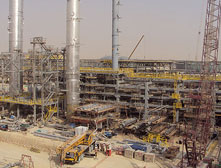
Ethylene’s importance as an important feedstock in the petrochemical industry is highlighted by the130 million tonnes that was processed worldwide in 2013, according to a report by Ceresana. It also says ethylene revenues on the global market will increase by 3.2% annually, between 2013 and 2021
The Germany-headquartered industrial research group said applications included the three polyethylene (PE) plastics, namely, HDPE, LLDPE, and LDPE; as well as petrochemical intermediates: ethylene oxide (EO), ethylene dichloride (EDC), and ethylbenzene (EBZ).
Application growth areas
The "Market Study Ethylene" report says that the PE industry will continue to consume a majority of all ethylene produced. In 2013, about 63% of global demand for ethylene was accounted by producers of these plastics.
While demand for LDPE is anticipated to increase only moderately, high growth rates for the products HDPE and LLDPE are projected in Asia Pacific and the Middle East.
Meanwhile, another application area of huge growth potential is EO, which is mainly used to produce ethylene glycol -- a pre-product for polyester.
By far the most important EO-based product is ethylene glycol, which is mainly needed for the production of PET. Thus, the growing substitution of glass by PET bottles and containers will see global demand for ethylene in the production of EO to increase by 3.2% per year.
Other applications of EO include non-ionic surfactants, polyols, ethanolamines, and glycol ethers. In recent years, production of PET has increasingly shifted from Western industrialised countries to Asia, in particular, China, which is projected to have the highest growth rates for the ethylene glycol markets; whilst Western European producers will have to increasingly focus on the production of alternative EO-based products.
Cheap shale boosts capacity; Westlake to increase capacity
One striking finding in the report is the implication of the shale gas boom, particularly in the US, as well as in Eastern Europe in ethylene market growth.
In the US, the shale gas boom has enabled low-cost ethylene production. Thus, the strong decline of prices for ethane has led to a number of new ethane crackers being built. Because of this, several European manufacturers have announced to either close their crackers or to change over to using imported ethane as feedstock.
Capitalising on cheap shale gas, the US continues to increase its output of ethylene. Meanwhile, Eastern Europe, dominated by Russia, and Africa are also expecting to see a high relative increase of production volume of ethylene.
Meanwhile, Eastern Europe, dominated by Russia, and Africa are also expecting to see a high relative increase of production volume of ethylene.
In a related development, US firm Westlake Chemical Corporation is expanding its ethylene capacity in Lake Charles, Louisiana, with an investment in excess of US$330 million. This expansion is expected to be completed in late 2015 or early 2016 and will increase ethane-based ethylene capacity by approximately 113,000 tonnes/year.
Output up in Middle East; Sadara to build largest complex in the world
Elsewhere, in the Middle East, between 2005 and 2013, the region has become one of the most important for the global ethylene industry, following a growth of 9.1% per year. Output is likely to rise by up to another 10 million tonnes until 2021.
Exemplifying the lucrativeness of the region’s market, Jubail-based Sadara Chemical Company is targeting to up its ethylene production. Currently, it is building the largest chemical complex in the world, ever constructed in a single phase.
Sadara is a joint venture between the Saudi Arabian Oil Company (Saudi Aramco) and Dow Chemical. With a total investment estimated at US$20 billion, Sadara is building a world scale chemical complex in Jubail Industrial City II.
Comprised of 26 world scale manufacturing units, the Sadara complex will be the first in the Middle East to use refinery liquids, such as naphtha, as feedstock.
By using best-in-class technologies to crack refinery liquid feedstock, Sadara says that it can enable many industries that either currently do not exist in Saudi Arabia or only exist through imports of raw materials. The adjacent PlasChem Park, a collaboration between Sadara and the Royal Commission for Jubail and Yanbu, is expected to create more value downstream, and generate investments, innovation, economic growth and jobs.
The company is on track to deliver its first products in the second half of 2015, with the complex in full operation in 2016.
Ziad Al-Labban, CEO of Sadara, commented recently that currently, the Middle East accounts for almost 20% of global ethylene capacity compared to 12% five years ago, and thus, is the world’s third largest region for ethylene production.
He was speaking at the recently staged forum, Ethylene Middle East Technology (EMET) 2014,held in October in Manama, Bahrain.
He furthered that the region continues to tap opportunities to further develop its chemical industry by capitalising on the abundance of natural resources, and cost effective feedstock pricing. It also relies on having strong regulatory and industrial infrastructure, as well as being in close proximity to markets with growing demand for its products.
(PRA)























